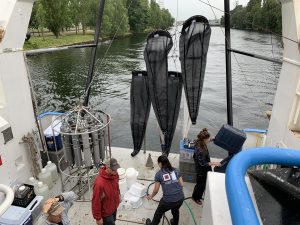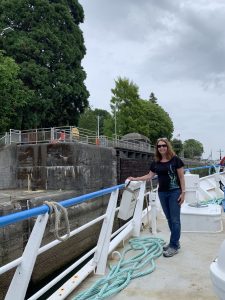UW and Smithsonian researchers develop DNA identification methods for monitoring Salish Sea planktonic communities
From the Winter 2023/2024 Sea Star
By Katalin Plummer, WSG Science Communications Fellow
Sometimes it’s the smallest living things that can tell us the most about the state of the ocean. For decades, scientists have tracked the diversity and abundance of plankton — microscopic organisms that include larval fish (ichthyoplankton), other small animals (zooplankton), and photosynthesizing bacteria and protists (phytoplankton) — on the surface of the ocean. Traditionally, this type of survey work is completed by towing a fine mesh net behind a boat, analyzing the samples under a microscope and identifying and counting individuals by hand. Such methods are both time-consuming and prone to inaccuracies, as many species are difficult to distinguish.

Fine mesh nets used to trap plankton for analysis. Photo credit: Carol Stepien.
Thanks to recent technological advances, scientists can now address these shortcomings with the incredible capacity of DNA. Through the use of DNA extraction, amplification and high-throughput sequencing techniques — known as “metabarcoding” — scientists can take those same towed samples and identify numerous species more quickly and with greater accuracy. Think of it like trying to recognize each person at a crowded party: the microscope method would be like going to each partygoer one by one and asking their name, while the metabarcoding approach would be like simply looking at the attendee list.
But metabarcoding techniques are still under development as scientists fine-tune the appropriate protocols for their areas of interest. That’s why oceanographer Julie Keister and molecular ecologist Carol Stepien led a Washington Sea Grant-funded study to couple the two techniques for their community assessment of the Salish Sea.
“Microscopy identification is considered the gold standard for identifying organisms — that’s how we’ve done it for centuries,” says Keister, who is a professor at the University of Washington. By using this “gold standard” alongside the newer methods, the researchers were able to validate their metabarcoding results. “One of our main goals with this study was to resolve the identities of members of complex communities more efficiently and accurately,” says Stepien, who is a research associate at the Smithsonian Institution’s National Museum of Natural History. Species can be difficult to identify accurately based solely on their physical characteristics, so the metabarcoding method allows scientists to distinguish among species that may look incredibly similar.
The researchers had to choose their DNA markers wisely. DNA markers are snippets of gene sequences that act as DNA bookmarks; different markers will highlight different plant and animal species. Keister and Stepien’s team used multiple markers to maximize the number of species they could identify as well as confirm that different markers yielded the same identification for one individual. “We went into this study knowing that it was unlikely that any one marker would identify all of the organisms [in a sample] because there is such a breadth of diversity [in the Salish Sea],” Keister says. They decided on markers that were known to work well for a variety of taxa, particularly those that are economically important, ecologically critical, sensitive to ecosystem variability, or a combination of the above, such as crustaceans.

Stepien returning through the Ballard Locks post-sampling. Photo credit: Carol Stepien.
The team reports that the metabarcoding method identified a multitude of organisms to the species level and found several species that had been missed in microscopy identification. The researchers think the new metabarcoding methodology could be key for detecting and monitoring rare species, including threatened organisms like chum salmon or invasive organisms like the European green crab or zebra mussel.
The results also show the potential of using metabarcoding to study climate change in the Salish Sea. Ocean conditions have been changing rapidly in recent years, primarily due to human activities. The organisms prioritized in Keister and Stepien’s study — small crustaceans, mollusks and fish — are particularly sensitive to the ocean becoming more acidic and to decreases in oxygen levels. These small animals are key food sources for larger organisms and therefore form an important part of an ecosystem that provides humans with cultural, economic and ecological value. “As we develop these methods that can identify different types of taxa with higher resolution than we could ever do with a microscope, we may find more sensitive indicators of climate variability,” Keister says.
“The plankton really are the pulse of the ocean,” says Stepien. They serve as the base of the food chain, meaning that plankton biodiversity is critical to maintaining the tremendous diversity of bigger animals like fish and whales. “Metabarcoding and other exciting new tools can help determine who is where in the ocean at any given time.”
This study contributes invaluable protocols that could allow the scientific community at large to study the ever-fluctuating Salish Sea reliably. “We’re asking what are the things that scientists want to know now,” says Keister. “And we’re working to focus on those methods.”
###
Washington Sea Grant, based at the University of Washington, helps people and marine life thrive through research, technical expertise and education supporting the responsible use and conservation of coastal ecosystems. The National Sea Grant College Program is part of the National Oceanic and Atmospheric Administration, U.S. Department of Commerce.
Join the conversation: instagram.com/waseagrant and Facebook.com/WaSeaGrant.
FEB
2024